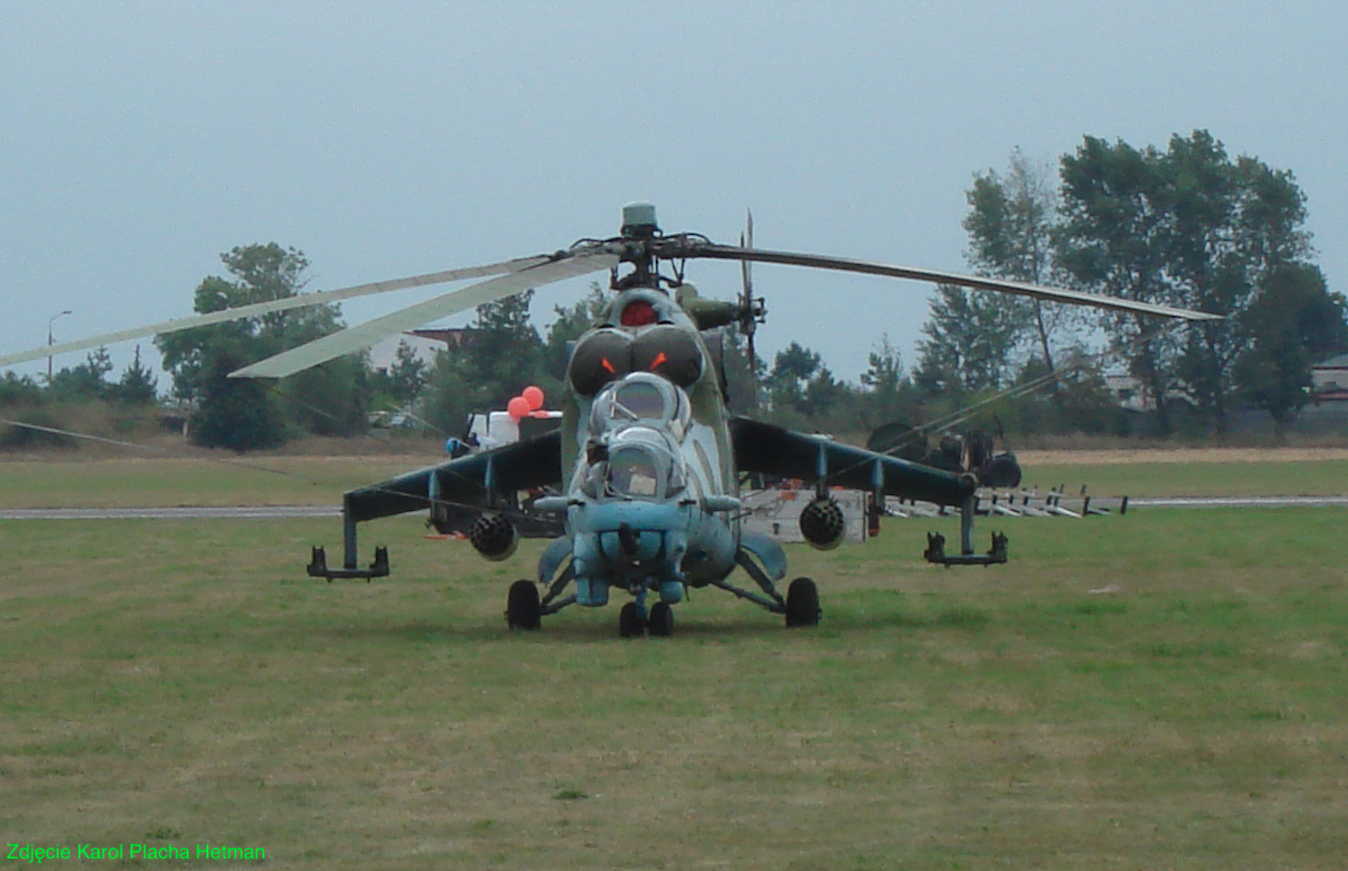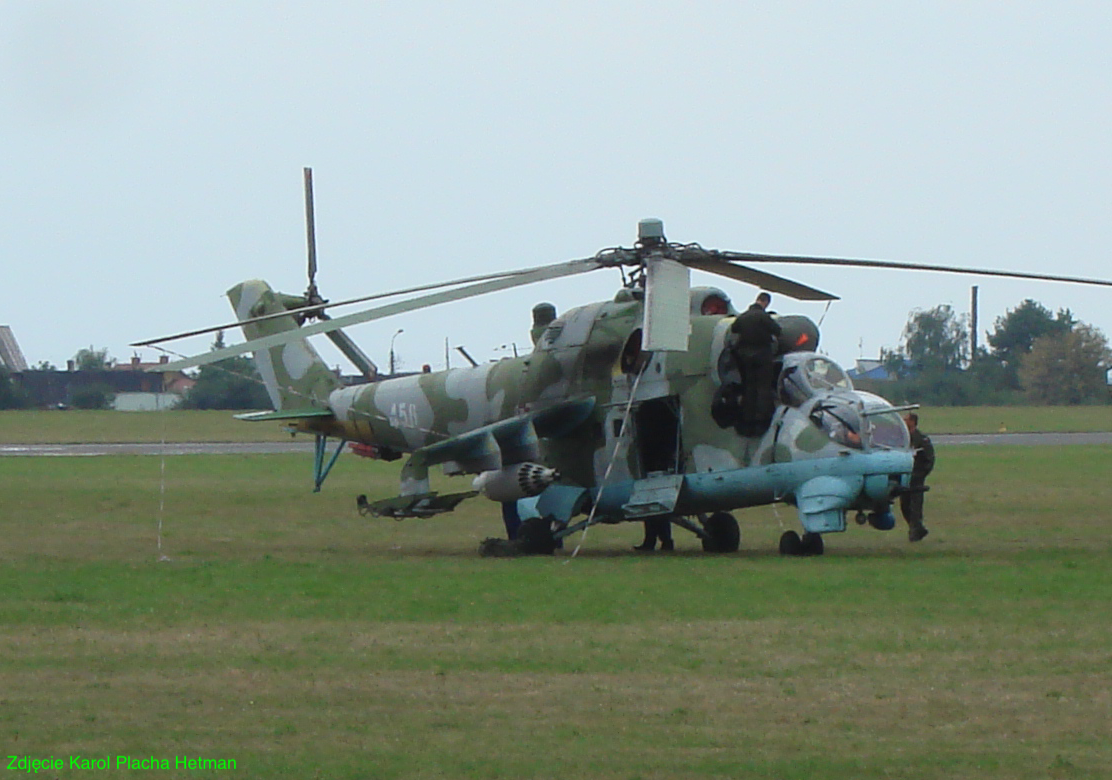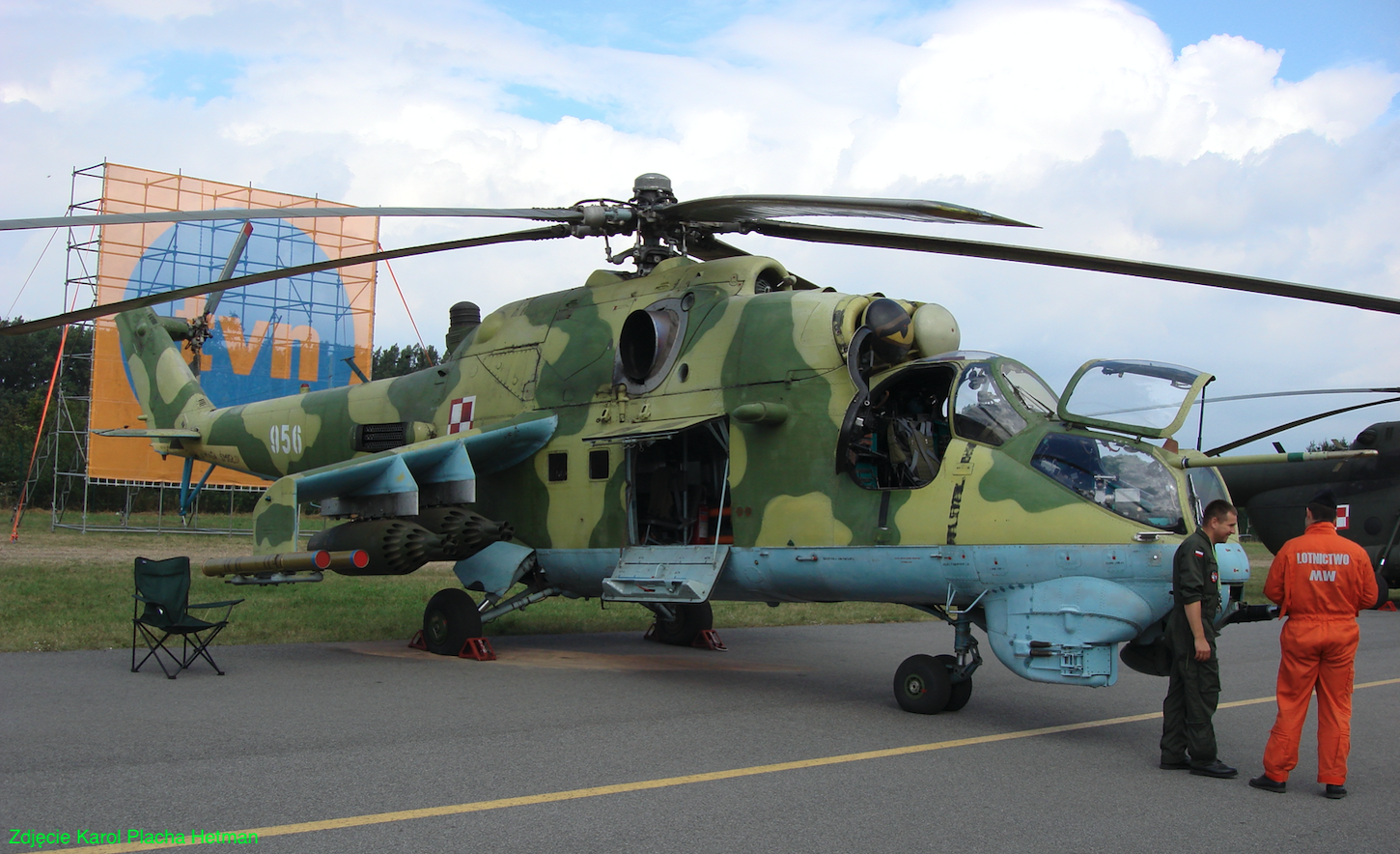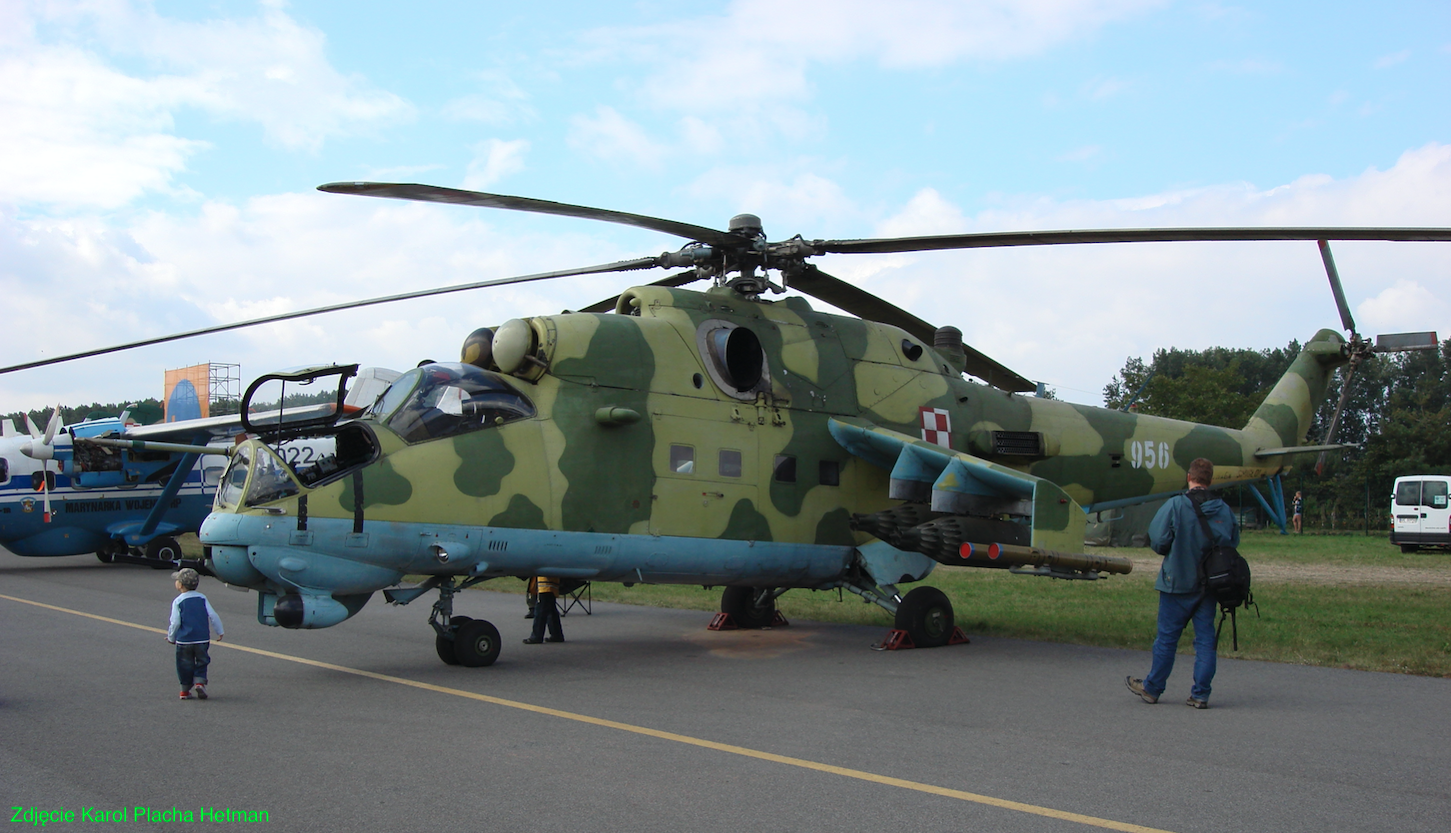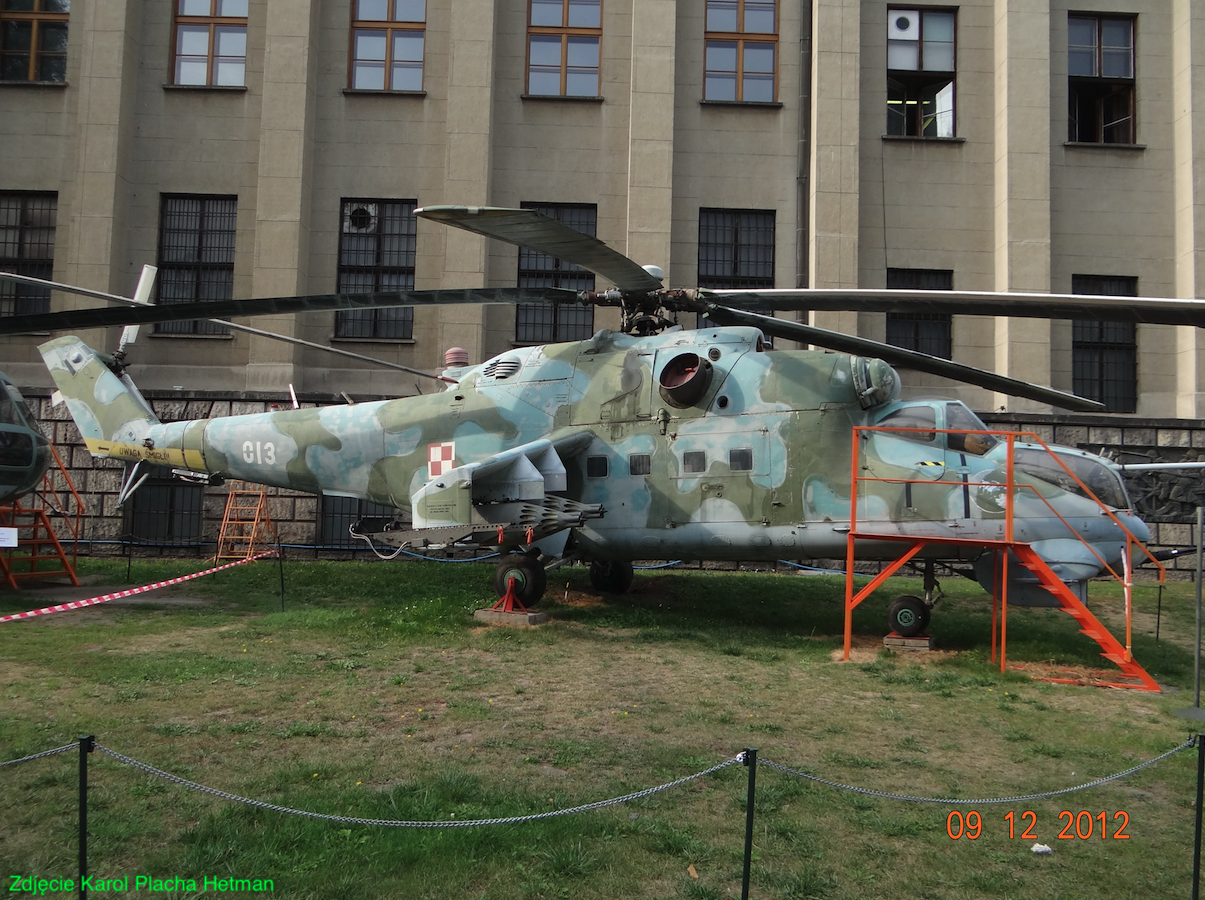Warszawa 2018-04-11
Mikhail Leontyevich Mil Mi-24 attack helicopter.
245a Section 20.09.1978 year. Poland.
History.
Development of the Mi-24 design.
The Mil Mi-24 is a medium attack helicopter. At the time of development, it was a sensation among attack helicopters – at the same time it served as a typical attack and landing helicopter for the team. The helicopter is designed to destroy point targets: tanks, artillery emplacements, bunkers, bridges and enemy manpower.
The history of Mil Mi-24 began in the late 1960s. The Soviets meticulously collected information on the use of helicopters during the war in Indochina. Like the Americans, the Soviets saw great advantages in using helicopters on a battlefield where the enemy had the upper hand. They began to analyze the creation of a relatively universal battlefield helicopter. The task was entrusted to the OKB office of Mikhail Mil. Mikhail Mil himself was already seriously ill at that time. The task force was headed by Marat Tishchenko.
In the studies on the Mi-24 helicopter, you can find the term heavy or medium, which is a big difference. This apparent inaccuracy arises from the interpretation of these terms. If you consider this helicopter against the background of all helicopters, it is certainly average. However, when we look only at combat class helicopters, the Mi-24 is definitely a heavy helicopter.
In order to speed up the work on the new helicopter, the Soviets decided to use one of the existing structures. The Mi-2 and Mi-8 helicopters were considered. The problem is that the Mi-2 helicopter was mass-produced only in Poland in Świdnik, and the CCCP’s mistrust of Poland was high. However, if the Soviets had relied on the Mi-2, a helicopter similar to Western designs would have been created. Finally, the Mi-8 helicopter was selected, from which many components were used. Among them; main rotor and tail rotor, main transmission, engines and the middle part of the fuselage structure. The front part of the hull was completely rebuilt. The pilots’ seats were left in the side-by-side arrangement. Initially, the crew was to consist of as many as four aviators: two pilots and two weapons operators. This was due to the gun control systems requiring the missiles to be tracked and guided until they hit the target. The tandem cabin layout was introduced a little later, when analyzes showed that two pilots were able to effectively control the helicopter and its weapons. Thanks to the tandem arrangement, it was wanted to reduce the frontal resistance of the structure. There was a long debate over who should sit first: the pilot or the weapons operator. Finally, the pilot sits in the second cabin. The cabin was spacious, but placing the seats on the same level meant that the second pilot had a limited field of view. So the work continued and finally the rear seat was raised, as was already done in training and training aircraft.
In 1969, a full-size helicopter model was built. The design was designated W-24 (Вертолет-24). The first flight of the W-24 took place on September 19, 1969. The crew commander was Herman Alfiorov. It was already then decided that the helicopter needed to be rebuilt. The first change was the reduction of the main rotor (its diameter). This allowed the tail boom to be shortened. This made the helicopter more maneuverable. The fuselage received a smaller diameter. This resulted in a limitation of the soldiers with equipment taken on board. Previously, the hull housed a team of 12 people. Now only 8 people. The most important elements of the airframe structure are armored. Small wings were added, the main purpose of which was to suspend weapons under them, but also to increase the range.
At this point, it is necessary to pay attention to the markings of the Mi-24 helicopters. Initially, the helicopter was to receive Mi-8 designations with prefixes. The Mi-24 helicopter among Soviet pilots was called Fat, due to the shape of the fuselage. In contrast, NATO gave it a name, standardly beginning with the letter H; Hind, or Doe. Letters of successive versions recognized by the West were added to the name Hind: A, B, C, etc. As a result, it turned out that in the literature on the subject, versions typed by the West are given more often than Soviet designations, which are digital. As a result, the Mi-24 A version is the first production version, and the Mi-24 B version is a pre-production series. The only differences are in the mounting of the armament (Mi-24 A).
The Mi-24 A received a movable 12.7 mm A-12.7 machine gun. Unguided missiles were suspended under the wings. The basic armament was to be guided missiles, anti-tank missiles. But at that time they were in the development phase.
The new helicopter, with a large, glazed cabin, and TW2-117 A engines, had very good performance. Especially forward speed. This prompted the engineer Marat Tishchenko to build a record-breaking copy, which received the designation A-10. On this specimen, the crew: female pilot engineer Galina Rastorguyeva and female navigator Lyudmila Polanska (professionally a navigator of the Il-18 aircraft) in 1975 set several FAI records. Among other things, on July 18, 1975, the speed in a 100 km circumference was 334.464 km/h. On August 1, 1975, the speed in a 500 km circumference was 331.023 km/h. On August 13, 1975, the speed in a circuit of 1,000 km was 332.646 km/h. This crew also set time-to-climb records. On August 8, 1975, 2 min 33 sec at 3,000 m. On August 26, 1975, 7 min 43 sec at 6,000 m. At that time, the TW3-117 engine was certified for operation. These engines were mounted on the A-10. On September 21, 1978, pilot Gennadi Karapetyan achieved a speed of 368,400 km/h based on 15/25 km.
TW3-117 engines were installed in a serial helicopter, and this is how the Mi-24 C version was created, without armament, intended for transport tasks for the army.
At that time, weapons systems for the helicopter were being developed. Efforts were made to develop effective armament and ways to fight tanks. The use of a stationary 23 mm double-barreled cannon or a movable 12.7 mm machine gun (type YaKB-12.7) was considered. The use of a missile system code-named "Storm" was envisaged. The system had supersonic guided missiles Kokon 9M144 with anti-tank warheads, semi-automatic, radio-command guidance. Efforts were made to maintain the high forward speed of the helicopter (minimum 315 km/h) and the ability to perform a long hover at a minimum height of 25 m above the ground. High maneuverability was also a priority.
The most popular version of the Mi-24 D, which entered service in 1976, became a real revolution. The helicopter was sold to the Warsaw Pact countries: Bulgaria, Czechoslovakia, East Germany, Hungary and Poland. In addition to new engines, the helicopter received many modifications. The helicopter is a kind of hybrid of an assault and transport machine. It transports eight soldiers with full equipment. But interestingly, it did not completely replace the combat versions of the Mi-8/Mi-17 helicopter.
Serial production was carried out in Arseniewo, plant No. 116 (currently Progress plant) in the east of CCCP. Production started in 1970. The next production plant was Rostov-on-Don No. 168. Mi-24 production lasted from 1970 to 1989. Over 3,000 machines were built. The Mi-35 helicopter is a further development of the Mi-24 helicopter. In the years 1992-2012, about 150 Mi-35 machines were built.
Mil Mi-24 in Poland. 1978.
The decision to purchase Mi-24 D helicopters for the Polish Army was made in the mid-1970s. In April 1978, a team of 10 pilots and 24 technicians were selected to train for the new technique at the CCCP site. Most of the Polish personnel came from the 37th Transport Helicopter Regiment, Leźnica Wielka near Łęczyca. The training lasted four months.
The first four Mi-24 D helicopters arrived in Poland on September 20, 1978. The helicopters had Nos: A1013, A1014, A1015, A1016. They were brought by Soviet pilots. Helicopters were given the appropriate nb 13, 14, 15, 16. Initially, the helicopters remained on the ground, because the training of the Polish personnel was not finished yet.
The first batch of Mi-24 D helicopters officially began operating on January 1, 1979. Second lieutenant pilot Andrzej Fryc was appointed as the commander of the flight. The flights began on January 11, 1979, when the weather conditions improved. The first stage of training was completed relatively quickly. On April 22, 1979, a group of Mi-24 D helicopters was transferred to Świdwin Airport and combat training began using nearby training grounds. Combat readiness was achieved in mid-1979. Mi-24 D helicopters took part in the autumn military exercises "Jubilee 79".
The Mi-24 D was first publicly presented on June 27, 1979, at the Dęblin Airport on the occasion of the first anniversary of Mirosław Hermaszewski’s space flight (1941 – 2022).
Placing Mi-24 combat helicopters in Leźnica Wielka, where transport helicopters were stationed, was illogical. Therefore, the squadron was transferred to the 49th Combat Helicopter Regiment (Pruszcz Gdański).
Another four Mi-24 D helicopters (Nos. 103174, 103175, 103176, 103177) flew to Poland on October 20, 1981, landing at Pruszcz Gdański Airport. In October 1984, six helicopters (No. 410456, 410457, 410458, 410459, 410460, 410461) were delivered to the 49th Combat Helicopter Regiment (Pruszcz Gdański). On July 1, 1985, the last two Mi-24 D machines were delivered; No. 410584 and 410585.
The next helicopters belonged to the Mi-24 W version. The Mi-24 W helicopter version differs from the previous Mi-24 D mainly in the guided armament system (carrying eight 9K114 Szturm-W missiles), and thus in the combat equipment.The first four machines arrived in Poland on April 24, 1986. In total, 16 Mi-24 W machines were purchased, which went to the 56th Combat Helicopter Regiment (Inowrocław Airport).
The last copies were obtained after 1989, after social and economic changes. In the mid-1990s, we received 18 Mi-24 D machines, previously used in East Germany, free of charge. As they were in poor condition, inspections and repairs were carried out in WZL-1. 16 machines were repaired. Two machines served as a source of spare parts. They entered the state of the 49th PŚB Pruszcz Gdański. The first ex-German Mi-24 D entered service on October 23, 1996.
The bases of Polish Mi-24 helicopters are Pruszcz Gdański and Inowrocław as standard. However, very often Mi-24 helicopters are based at Nowy Trag Airport. Here, the crews take advantage of the possibility of exercises in mountainous conditions. Polish Mi-24s operated in Iraq and Afghanistan.
Polish pilots of Mi-24 D/W helicopters evaluated them positively. "For 6 years I was the pilot of this machine, even though it looks heavy and clumsy, it behaves wonderfully in the air, I especially liked the fast flight right above the trees or in narrow valleys – an amazing feeling, and this firepower. Equipped with better and better avionics and armament, and at the same time simple operation in field conditions – they will probably serve for a long time."
However, currently, in 2017, the combat value of Polish Mi-24s is lower than before 2012. Polish helicopters simply do not have guided missiles. All missiles possessed by Poland have been used. Mi-24 D helicopters carried four missiles of the Falanga system, named Skorpion. The range of the missiles is 3,000 m. Mi-24 W helicopters, on the other hand, carried eight 9K114 Szturm-W missiles. The range of the missiles is 5,000 m. It is worth noting that this is not a problem only of the Mi-24 helicopters, but of all combat machines in Poland. Responsibility for this state of affairs falls on the Masonic-Liberal government of Poland with Prime Minister Donald Tusk, who pursued a policy of liquidating the state. It was only from 2016 that a framework solution to the problem was undertaken. Either new helicopters with new weapons, or new missile suppliers. The armament of the Polish Mi-24s are 23 mm cannons, 12.7 mm four-barrel cannons and unguided missiles.
Written by Karol Placha Hetman

